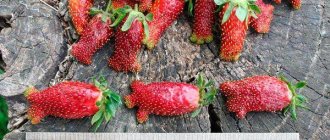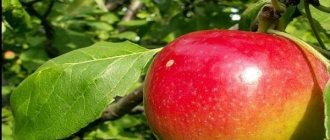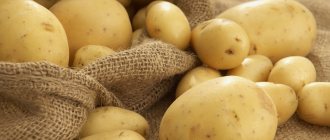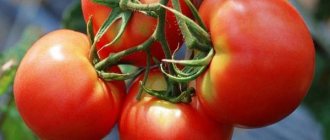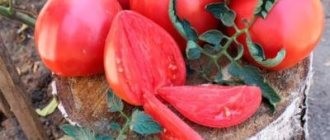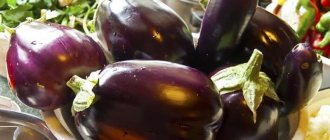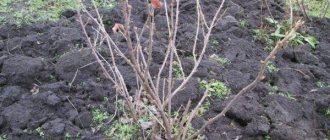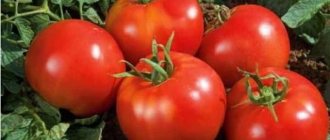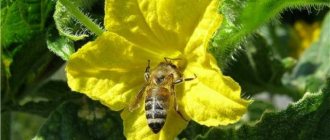Description and photo of the variety Good News
- Late winter variety . We got it by crossing Krasa Sverdlovsk and the immune form X-2034;
- Medium sized tree. And the crown is not that thick. Quickly gains its shape;
- Brown-colored and medium-sized pubescent shoots have characteristic knees. Not straight;
- The dark green and smooth small leaves are oval in shape;
- The fruits are round. Some people also see a barrel in them. So they call them barrel-shaped. Their sizes are approximately the same. From 85 to 120 grams.
Apple tree fruits Good news.
Interesting digression:
- I always smile when they indicate the weight of apples with an accuracy of 5 grams. And definitely 85 grams. I would like to ask those who carried out the weighing. Where did you get the apple?
- Every gardener knows that the weight and size of apples, even on the same tree, are not the same. There are big ones. There are small ones. And there are averages between them. And when purchasing them on the market, you try to take larger and more beautiful ones;
- That’s why you and I will smile at the phrase from one article: “The fruits are round. Correct shape. Weight 85 grams."
Very attractive in appearance - yellow with a pink blush. There are few subcutaneous points on the apple. But there are them too. Although not that noticeable. With creamy, dense, fine-grained and juicy pulp. Great taste. Sweet and sour. With high ratings from tasters . They also note a weak aroma.
Apples Good news.
Varieties
The main variety Good News has varieties: standard variety and Blagovest. They have similar descriptions to the main variety.
Apple tree standard Good news
Practically no different from the main type. It is classified as a creeping variety in the form of a shrub. The tree is compact, reaches 2 m in height. The apples are medium in size and taste sweet and sour. The color is yellow with a pink blush.
Blagovest
This variety is more suitable for cultivation in the Central region and the Black Earth region. The tree is compact, the crown is round. The apples are medium in size and taste sweet. There is no resistance to scab, winter hardiness is preserved. Moisture-loving culture.
additional characteristics
Advantages and disadvantages
- Scab-immune variety;
- High winter hardiness;
- Long shelf life;
- Very tasty.
Dimensions of an adult tree
- On a seedling rootstock. Quite large trees. When they grow up. Beautiful round shape. Like a ball;
- On semi-dwarf rootstocks. Medium sizes. And the form is the same.
Good news on seedling rootstock.
Annual growth
- The shoots are evenly distributed throughout the crown;
- Medium vigor.
Frequency of fruiting
- The variety does not force you to do calculations: is this the right year for it to bear fruit?
- It bears fruit regularly;
- And your concern will be in preserving these delicious apples.
The good news bears fruit regularly.
Productivity
- Many gardeners who grow apple trees of this variety and eat such apples do not particularly focus on their yield;
- Although it is not as high as many well-known industrial varieties. Apparently, for them, productivity does not come first;
- But farmers share little information. They have no time!
Tasting assessment
- its tasting score is 4.8 points
- And these are not only tasters from the Urals, Siberia and Altai.
The fruits of the Good News have a high tasting rating.
Winter hardiness
- The winter hardiness of this variety may be the envy of other varieties;
- And gardeners in the Urals, Siberia and Altai successfully grow this variety on their plots;
- They also advise growing it in milder areas.
Resistance to scab and other diseases
Scab is really ahead of all apple tree diseases:
- It may leave you without a harvest of your favorite apples. Who will like it;
- The winter hardiness of the tree also decreases;
- So scientists are working to create scab-resistant varieties. Including immune ones.
Apple tree varieties are divided into:
- Immune to five races (there are only five of these races);
- Immune to four races;
- Varieties with so-called field resistance. Its degrees: low;
- average;
- high.
Advice! Plant a Good News apple tree that is immune to all five races. And you won't even think about this problem. This allows you to successfully resist other diseases.
Tree planting
Planting an apple tree is carried out taking into account preparatory measures and the correct timing of the procedure. They approach planting competently so that all stages are completed sequentially.
Preparing the soil for planting seedlings
The site in the garden for the fruit crop must be chosen at an elevation so that the groundwater lies at a depth of 2 meters from the surface of the earth. The place should not be exposed to cold winds. 3-4 buckets of humus, superphosphate and potassium salt are added to the site in advance. The fertilizer components are dug up along with the soil. The resulting blocks of earth must be broken.
Marking out the area for planting
Before planting seedlings, you need to mark the area where to place winter types and where summer types of apple trees. For the Good News variety, you need to prepare a place on the northeastern or northwestern slopes. It is best to place trees at a distance of 2-3 meters from each other, and measure 1 meter between rows.
Soil preparation
Before planting apple tree seedlings, the soil in the garden is plowed to a depth of 40 centimeters. After applying manure (4-6 kilograms) along with superphosphate - 50 grams, potassium salt - 30 grams and ammonium sulfate, thoroughly harrow the area.
Digging a hole for seedlings
The pit must be prepared at least 2-3 weeks in advance. If apple trees are planted in the spring, then autumn preparation of planting holes is necessary. When digging, the top layer of soil, which is more fertile, is folded on one side. The lower one is folded in a different place. The depth of the hole should be between 50-60 centimeters, and the diameter should be 70 centimeters. On loose soil, the holes are made wider. The bottom must be loosened.
Secrets of choosing seedlings
Apple tree seedlings should not be more than 2 years old. If the seedlings were buried, then before transportation the roots should be dipped in a mixture of earth and clay. In this case, the fibrous root system will not dry out. You can keep the seedling in water for 24 hours before planting. After examining the roots, remove dead and damaged parts. If the branches of the shoot are not branched, then cut off the top at a height of 40 centimeters.
Disembarkation dates
The best time to plant a Good News apple tree is in the spring before the buds open. Usually the deadline falls at the beginning of April. In autumn, the tree must be planted before October 10. If the seedlings are received later, it is better to bury them in grooves up to 50 centimeters deep. The root system of apple trees is carefully covered with earth, compacting the soil on top. For protection, you can put a layer of brushwood or material on top.
Disembarkation procedure
Planting begins by adding humus and mineral fertilizers to the hole, having first mixed them with the ground. Having filled the hole to 3 quarters, pour a mound from a bucket of humus or a nutritious top layer on top. Holding the seedling with one hand, pour soil with the other, shaking the apple tree periodically. Make sure that the root collar is at soil level or slightly higher. A peg is placed nearby to which an apple tree is tied.
It remains to compact the soil in the root circle, pressing it with the soles from the edge to the trunk of the tree. Then they make a roller to form a hole. At the end, water generously, up to 5 buckets per hole, apply a layer of mulch when the water is absorbed.
Reviews
Leonid. “For our places (and this is Bashkiria), among winter varieties, I would give preference to the Good News variety. This is truly a wonderful result of the Ural gardeners. And Kotov’s varieties deserve attention and respect. Reliable. They have just started to bear fruit for me. I will check their stated characteristics. But the taste and appearance completely satisfy me. I won’t say anything about keeping quality yet. But in March we still ate apples. I advise others to purchase this variety. I don't write about illnesses. There were no problems."
Stanislav. “I specifically purchased a Kotova Blagovaya Vesti apple tree for my garden because I liked the photo and description of the variety. Through reliable channels. So that there are no mistakes with the variety. And she didn't disappoint me. After all, there is a lot of talk about how local varieties are not very tasty. And it's not just delicious. It is very tasty. And fragrant. And it is stored until April. No special conditions. Add to everything that I said that this is an immune variety to scab. About low yields. Everyone has their own criteria. Our family has enough apples. But they advise you to think about good pollinators nearby.”
Michael. “An excellent winter apple variety for the Urals and surrounding areas. Please note that not so long ago there were no such gardens in our area. The gardeners had something. I have several Ural varieties - Silver Hoof, Krasa Sverdlovsk, Issetskoe later, Good News. I'm happy with everyone. Of the later ones, of course, is Good News. This is our family's favorite. Juicy, Fragrant. And this is in March. True, their productivity is not so high. But that’s what other apples are for. And to compare with each other.”
Planting a seedling
When choosing a location, it is better to give preference to an area where there are no obstacles to sunlight and no drafts.
When choosing a location, it is better to give preference to an area where there are no obstacles to sunlight
Apple tree Rozhdestvenskoe
The yield will be higher if the site has fertile soil, the pH level of which is closer to average (5.5-6). If the acidity of the soil is high, it is recommended to liming it before planting. You can also use dolomite flour, which is added to the soil before loosening.
Important! If a decision is made to lim the land, phosphorus fertilizers cannot be used to fertilize the site. They do not combine with lime.
Planting of seedlings should be done in early spring. This will give it time to settle in well and get stronger before the start of winter. You should start preparing a hole for planting a seedling no earlier than 1 month in advance. Its dimensions can be approximately 0.80-1 m. A fertile mixture is added to the pit, which consists of chernozem, peat, superphosphate and wood ash, taken in equal quantities.
The distance between the pits on the site depends on the size of the crown. It should be such that mature trees do not shade each other. Otherwise, the yield will decrease. The optimal distance is considered to be from 2 to 4 m.
A peg is driven into the central part of the hole, which should protrude above the top of the hole to a height of 35 - 55 cm. The trunk of the seedling will be tied to it when it is planted. The pit should remain in this condition for a month. This is necessary for the soil to settle.
When planting, the trunk of a seedling must be tied to a peg
Immediately before planting, the root system of the seedling is placed in clean water for 2 - 3 hours. This will help it absorb moisture and gain strength.
The seedling is placed in the center of the planting hole, and its roots are carefully straightened. The hole is filled with soil mixture, which is then compacted. Around the trunk you need to make a ditch near the trunk with a distance of 35 - 60 cm from the trunk. The tree will be watered through it. After landing, up to 3 buckets of water are poured into the ditch.
To retain moisture, the soil near the tree needs to be mulched. You can use hay or dry grass for this. The thickness of the mulch layer should be at least 5 cm. The tree should be watered again after approximately 7 - 10 days.
Features of planting and caring for an apple tree
Planting dates and scheme
There are no recommendations for the exact planting date of this variety. As for all apple trees. And various circumstances may make adjustments to these dates. Planting can be done both in spring and autumn. Focus on specific weather conditions:
- Spring: suitable period - April;
- the buds have not yet bloomed;
- but the soil has already warmed up.
- the leaves have fallen;
Watch a video about planting an apple tree in the spring: And a video about the features of autumn planting: Tips:
- Do not plant in wet soil in rainy weather;
- If it’s autumn like this, bury the seedling. Cover well for the winter.
You will select the distances between trees taking into account the rootstock of the seedlings. In rows it will be 3-4 meters apart on seedlings. And on dwarfs up to 3 meters.
Attention! Keep an eye on the root collar. It should not be buried. 4-6 cm above ground level. After the soil has settled.
Agricultural technology and cultivation
- Choose a suitable location and soil: Well-lit and exposed to sunlight;
- Light (loamy and sandy loam) soil.
- Biennial and with a good root system.
- Keep the soil in good condition: Systematically loosen and mulch.
- Two or three waterings may be sufficient. And then the weather will tell you;
- From the second year. Fertilize together with root watering. Foliar ones are also quite effective.
- The creators took care of counteracting diseases;
Treatment of the garden in the fall from pests and diseases.
Important! Pay serious attention to preparing the apple tree for winter and protecting it from rodents.
Rootstock for variety
You can purchase and grow this variety as a seedling. But they are often offered on semi-dwarf rootstock 54-118. Who needs what!
Pruning and crown formation
Prune in the spring before the buds open. But adjustments to green shoots can be made during the summer. These could be cuttings:
- Formative;
- Sanitary;
- Rejuvenating.
And the shape of the crown will be determined by your ideas and fantasies. Traditional and natural:
- Sparsely tiered;
- Cupped.
are very popular these days :
- Fusiform;
- Palmettes;
- Cordons;
- Creeping.
Palmetta.
And in the next video you will see how to form a creeping crown:
Pollinator varieties
- Varieties with the same flowering period planted nearby will only contribute to good pollination of the variety;
- Including Ural varieties;
- Apiaries near the garden are just a dream for a gardener.
Features of growing Good News
Landing
Basic conditions
- Apple trees love moist, fertile soils that are well-permeable to air and moisture. But they will grow on any land if they are provided with the proper conditions and care.
- Sunny areas are the best place to plant Westies. She loves it when the crown is illuminated by ultraviolet light most of the day. The only thing to watch out for is sunburn when the weather is too hot.
- It is advisable to choose the location of groundwater at 2-2.2 meters so that there is no risk of roots plunging into it. If the apple tree reaches moisture, it will begin to rot and die, as if for no apparent reason.
- The crowns must be provided with good ventilation so that air never stagnates in them. At the same time, it is important to avoid drafts, which increase the risk of disease in the garden.
- In the nursery or private farm where you are planning to buy seedlings, be sure to make sure that they have the appropriate documentation (certificates). Pay attention to the crown and rhizome, they should look healthy, there should be no broken or dry shoots, and the grafting site should be clearly visible.
- It is advisable to prepare a place and dig holes in it for the garden in advance, at least a month before planting in the fall or in the previous season in the spring. A depth of 50-70 centimeters is sufficient, and a diameter of up to 90-100. A little fertile soil mixed with fertilizers is added to the bottom, covered with drainage, filled with water and not covered with anything.
- It is immediately advisable to dig trellises or single stakes for garter into the holes. The Westie's rhizome is weak, so fairly strong winds can knock it over. In addition, the support will provide additional protection in cold weather if it is placed north of the trunk.
- If you decide to preserve the properties of the rootstock, then the grafting site should be left 5-8 centimeters above the surface, taking into account possible subsidence of the soil after the initial watering.
- The seedling is placed on a drainage pile, the roots are straightened, sprinkled with earth and lightly trampled. Water the top with 3-5 buckets of water and mulch the surface.
Disembarkation dates
Both spring and autumn planting options are equally suitable for trees. The main thing is that the soil is well warmed up and frosts are not expected in the next 21-30 days. Most often, trees are planted in March-April or September-October, after the end of leaf fall.
Tree care
Protection from frost and pests
It is very important to stop adding moisture to the trunks no later than August. If this is not done, then the apple trees will not have time to prepare for winter and stop the movement of juice in the trunks in time. Small trunks can be covered using the tent method, and larger ones can be wrapped in burlap, roofing felt, tights or any other materials. Straw or hay and spruce branches are thrown onto the root branching zone (crown projection), but in the harshest areas, 10-20 centimeters of soil can be heated. All this should be removed in early spring.
Treatment with industrial products works well against insects, but many gardeners limit themselves to whitewashing the trunks with a thick solution of lime. They are whitened twice a year, this additionally adds neatness to the garden. You can repel rodents using grease, fuel oil or melted lard. It is spread thickly on the lower part of the trunk.
Loosening the soil, watering: proper agricultural technology
You need to dig up the soil near the trunk twice a year, also in spring and autumn. You should not go too deep so as not to damage those roots that run shallow. Half or two thirds of a shovel bayonet will be just fine. After each watering, be sure to lightly hoe the soil so that it does not become too loose and there is free access to oxygen to the rhizome. At the same time, you can remove unnecessary debris from under the apple tree, such as rotting fruits and fallen leaves.
You cannot allow the soil under the tree to completely dry out, so you will have to water it quite often. This point is especially important in dry, hot years. Top dressing and fertilizers are mixed with water, which are recommended to be applied no earlier than 2-4 years.
Pruning: simple crown formation
A tree forms on its own as it grows and it is very difficult to force it to grow in any other way. Therefore, if you have no rooting experience, it is better to limit yourself to maintaining natural branching. Usually, seedlings come from nurseries with 2-4 skeletal branches and a central conductor, and these are the ones that will need to “dance.”
Every autumn, and sometimes spring, you need to clean the trees, cutting off everything unnecessary. Shoots sticking up or inside the crown, parallel branches, dry or broken are used for consumption. The cut areas are carefully covered with paint or varnish.
Reproduction
- Cuttings.
- Budding.
- Cloning.
- Kidney grafting.
Pollinator varieties
- Idared.
- Blagovest.
- Renet.
- The beauty of Sverdlovsk.
- Qandil is Chinese.
- Northern Sinap.
- Ural handsome man.
- Beauty of Bashkiria.
Diseases and pests
- Bacterial burn.
- Black cancer.
- Cytosporosis.
- Powdery mildew.
- Rust.
- Apple moth.
- Glassware.
- Psyllad.
- Shield.
- Hawthorn.
Features of ripening and fruiting
Fruiting
Start
- When you plant a seedling, make a mark on your calendar. To make sure in five years that there are already apples;
- And appreciate their taste. If you looked after her correctly.
The good news begins to bear fruit in the fifth year.
Peculiarities
- The size of the fruits and their harvest maturity depend on agrotechnical practices and quality care of the apple tree ;
- Fruits every year.
Deadlines
Blooms
- And apple trees bloom in May;
- Beautiful. And they delight those who care.
Fruit ripening
This is the Yaroslavl region. Ripen at the end of September. Sometimes in early October.
The fruits of the Good News ripen at the end of September.
Harvest storage
- You can store amazing and delicious apples until the end of March;
- One gardener kept it in a plastic bag until May;
- I couldn't stand it. I would eat it.
Agrotechnical measures
After planting, the main thing for the gardener will be to create a powerful and durable tree with the correct arrangement of branches
It is important to properly care for the soil in the garden
Apple tree care
Only competent care of the apple tree will allow it to bear fruit abundantly and protect itself from frost in winter, diseases and pests during the growing season.
Forming the crown
There are two ways to trim the crown - shortening and thinning. If the shoots are heavily branched, do not prune or shorten the shoots by only 1 quarter of the length. By annually cutting off the growth on the branches, a rounded crown is formed. If the branches grow by 30 centimeters, then they are not touched.
They stop shortening after the apple tree begins to bear fruit, in the 4-5th year of life. If the shoots extend beyond the crown, they can be trimmed. Thinning leads to lightening of the crown, and the fruiting zone shifts to the base of the shoots.
What to do when flowering
When the apple tree blooms in May, you need to pay attention to supplying the tree with energy. After watering, apply fertilizers
You can use chicken manure in a ratio of 1:12 or mullein - 1:5. Of the mineral complexes, superphosphate and potassium salt are important. Feeding is needed both during flowering and after it. If regular fertilizing is carried out, the fruits will set better.
Description and characteristics of the Imant apple tree, planting and growing rulesRead
To prevent flowers from being damaged by frost, you need to prepare smoke piles in the garden. They are lit when the air temperature drops to +2 degrees. They also use spraying of plants and watering them with water.
Soil irrigation
Moisture plays an important role for the apple tree. During dry summers, it is necessary to water 5-6 times. Additionally, you need to moisten the soil 3 weeks before you begin to harvest. One tree needs from 6 to 10 buckets of water.
Measures to protect apple trees from diseases and pests
It is imperative to take preventive measures for the Good News apple tree in order to protect against attacks by pests and pathogenic microorganisms. Diseases can be prevented by:
- regularly pruning damaged and diseased shoots;
- weeding the garden;
- loosening the root circle constantly when compacting the soil;
- digging up the site in autumn and spring;
- clearing the garden of fallen leaves.
Spraying with Bordeaux mixture or copper sulfate solution will help the tree stay healthy.
Fertilizer
For 1 square meter of planted apple trees that have entered the fruiting period, add 3 kilograms of manure, 50 grams of superphosphate, 15 grams of ammonium nitrate and potassium salt before loosening the soil. The following is added into the grooves laid along the rows of fruit trees:
- after flowering, bird droppings, dissolved in a concentration of 1:12;
- in July - complexes with phosphorus and potassium;
- a bucket of fertilizer for 2 meters of furrow.
Less fertile soils are fertilized more.
Pollination
The Good News variety does not require pollinators. It belongs to the self-fertile plants. But you can plant other varieties of winter apple trees nearby.
Ripening and fruiting
Apples ripen in the 4-5th year of the tree’s life. At first there are few of them, but every year the number of fruits grows. Apples ripen towards the end of September, when the harvest begins.
Apple Tree Good News
Stambovaya
What apple tree does not have a trunk? Right:
- Creeping;
- Formed by a bush.
And on clonal rootstock 54-118 you can grow a semi-dwarf apple tree of medium height. But half the size of an apple tree on a seedling. For 370 rubles.
The apple tree rootstock is semi-dwarf 54 - 118.
Advantages and disadvantages
The variety has its advantages and disadvantages. The positive aspects are noted:
- the fruits have a pleasant presentation;
- well stored;
- transportable;
- suitable for processing and fresh consumption;
- crop stability;
- disease resistance;
- winter hardiness;
- low tree.
Among the shortcomings it was noticed:
- in harsh winter conditions requires insulation;
- average yield;
- weakness of aroma;
- average fruit size.
Growing in regions
In the Urals
- In Bashkiria it is called the best winter variety . True, they add the word “apparently”;
- Mordovian gardeners are not overjoyed . After all, it is included in the state register in the Volga-Vyatka region. They offer it in their nurseries.
In the Altai region and Siberia
Due to its novelty, not everyone has yet been able to appreciate its benefits. And dignity. Or maybe we don’t see publications by Altai gardeners so often. And reviews.
So far there is no objective data on the cultivation of the Good News in Altai and Siberia.
Recipes for food and drinks
Many preparations for the winter are prepared from Good News apples:
- To make jam, take fruits that have been cleared of seeds and skin. They are cut, then blanched in boiling water for 10-15 minutes. Then immediately immerse in cold water. Per kilogram of raw materials, 1.3 kilograms of sugar are taken. Prepare syrup, add apples, bring to a boil and cook for 8-10 minutes. Then leave for 10 hours, then cook until tender.
- Apple juice can be prepared in a pressure cooker or juicer. Sugar is added to the juice to taste. Be sure to pasteurize the workpieces over medium heat for 10-20 minutes.
- To make jam from apples, first boil them and rub them through a sieve. The resulting puree is mixed with sugar, taking 2/3 cup per 1 cup of apple mass. Cook in an enamel pan over low heat, stirring constantly. The finished product should be brown.
Store apple preparations at a temperature not exceeding 10 degrees Celsius.
How to plant a tree on a plot
The landing procedure has its own characteristics and nuances. You need to study the algorithm, soil composition, recommended location.
Required soil composition
The apple tree prefers loamy or sandy soils. The acidity should be neutral or slightly acidic.
It is desirable that the land be fertile.
Selecting and preparing a landing site
The place should be well lit, protected from strong gusts of wind, and not shaded. Groundwater should be at a depth of no higher than 1.5 m.
They begin to prepare the planting hole in advance. Dig it out, then mix the soil from the hole with:
- 10 kg of humus;
- 300 g superphosphate;
- 200 g of potassium salt.
Half of the mixture is poured back and left for 14 days.
Important! The planting site is prepared in advance, from spring to autumn or from autumn to spring, but no later than 2 weeks before planting.
Dimensions and depth of the landing pit
The Good News apple tree is medium sized. A hole is prepared for it with a depth of 70-80 cm and a diameter of 70 cm. It is made in the shape of a circle or square.
Timing and step-by-step algorithm for planting an apple tree
Planting is carried out in the spring, when the soil warms up to 10 °C. The procedure is carried out following a certain algorithm:
- The roots of the seedling are immersed in water with a weak solution of manganese for 24 hours.
- Then the plant is lowered to the bottom of the hole.
- Straighten the roots with your hands.
- Gradually cover the plant.
- Compact the soil with your hands after each layer.
- Form a trunk circle 10 cm deep.
- Water with 4-6 buckets of water.
To protect the apple tree from strong winds or rain, before planting, drive a wooden stake and tie the plant to it.


